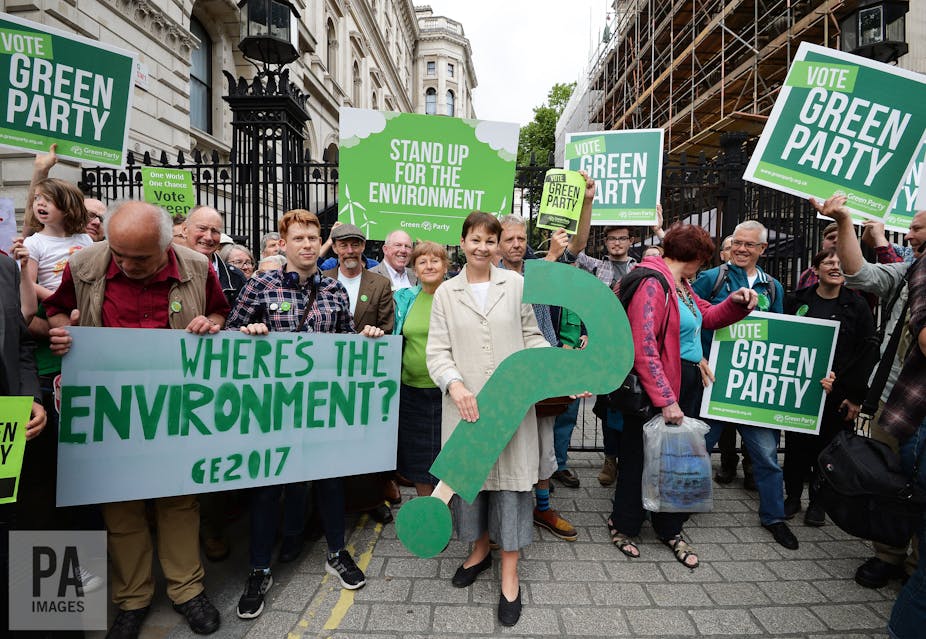The 2017 election could have been a serious opening for the Greens. The party fought the last election on a strong anti-austerity and redistributionist platform to the left of the Labour party, and established itself as a credible (if small) electoral force: its membership swelled to 75,000, the party quadrupled its 2010 vote count to 1.2m, kept a record 131 deposits, came second in four seats, and saw Caroline Lucas re-elected as its sole MP.
It seemed the stage was set for a bright Green future. But things have changed – and not for the better. Labour’s post-2015 shift to the left under Jeremy Corbyn and his personal popularity among young voters seems to have directly eaten into the Greens’ support. Far from building on their hard-won gains, polls suggest that while Lucas is expected to hold her seat in Brighton Pavilion, the party may do significantly worse this time.
This is not for want of trying. The Greens made several strategic adjustments to prepare for the next election. Most conspicuously, they returned to their old shared leadership structure, meaning Lucas – the party’s most prominent and effective media performer – could be freed up to be the face of the party while Jonathan Bartley played a lower-profile supporting role. This tactic has proved effective in the campaign. Lucas was widely judged a success in the televised leadership debates, and has consistently performed well in her other media appearances. But British elections and campaigns are tough for small parties, and when ComRes asked respondents their opinion of her just before the election, 62% had no opinion. Just 15% rated her favourably, against 23% unfavourably.
Strategically, the Greens have enthusiastically promoted the idea of a “progressive alliance”. They unilaterally announced they would not stand against at least 22 “progressive” candidates, meaning they’re running more than 100 fewer candidates than they did in 2015. But Labour did not reciprocate, even though the Greens’ gesture might well benefit many of its own candidates in marginal constituencies. The Liberal Democrats, meanwhile, were only prepared to stand aside for the Greens in Lucas’s south coast bailiwick – declining to help actually add any seats to the party’s tally.
True colours
In response to the rise of the “Corbyn effect”, the Greens’ 2017 manifesto departs radically from the one they published in 2015, an uncompromising 86-page tome of left-wing “tax-and-spend” proposals. This year the manifesto runs to a more digestible 26 pages; although it still includes a tranche of egalitarian, redistributionist proposals, it mostly sticks to more traditional territory by emphasising environmental and energy policies, democratic reforms and policies aimed at younger voters.
The Greens clearly see environmental policy as a chance to differentiate themselves from Labour. Despite promises to ban fracking, introduce a Clean Air Act and ensure that 60% of energy comes from zero-carbon or renewable sources by 2030, the Labour manifesto says very little about the environment, and makes far fewer pledges than the Greens.

But there’s stiffer competition elsewhere. The Liberal Democrats’ manifesto is almost as ambitious as the Greens’ on environmental issues, with a long shopping list of promises: a target of zero new greenhouse gas emissions by 2050, a diesel scrappage scheme, and a significant re-balancing of farming subsidies towards environmental stewardship.
Still, the Greens really do own the environment as a policy issue: one recent poll reports 51% of respondents identifying the Greens as the party best able to address environmental issues, far ahead of Labour (19%), the Liberal Democrats (9%) and the Conservatives (5%). The problem is that the environment just isn’t top of voters’ lists.
Overlooked
Despite the threat of Brexit, the air pollution crisis and Donald Trump’s decision to withdraw the US from the Paris climate agreement, polls show that only 5-7% of people identify the environment as one of the most important issues facing the country in the election – which means it doesn’t even make one of the top ten issues.
This will deeply frustrate the Green leadership, for whom Brexit could have been a major strategic opening. The EU has significantly shaped British environmental policy over the years, and as the recent Greener UK Hustings demonstrated, no one is certain what British environmental governance will look like once the Brexit process is complete. Many are deeply concerned that EU-derived green policies could even be dismantled wholesale.
The larger parties have all tried to reassure the public that environmental laws will not be swept away or weakened, but only the Greens use their manifesto to promise unequivocally to retain or enhance “all existing environmental laws”. That’s all very well, but it isn’t enough to shift the Brexit debate to a stage where the party can play a major role.
The party looks to be in for a disappointing election night. Lucas should be re-elected, but the Greens will struggle to make an impression anywhere else; for all their smart moves, they’re currently polling at around 2% nationally, putting them behind even UKIP. Crowded out by Labour’s leftward shift while the public tunes out on environmental issues, the Greens look set to be marginalised for some time yet.

